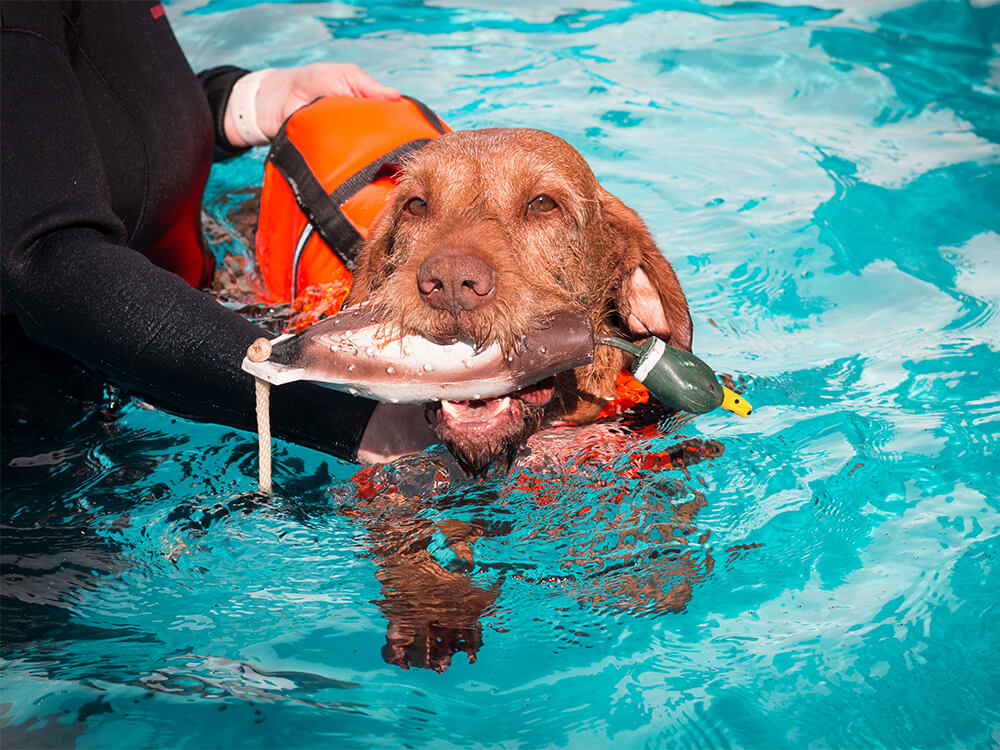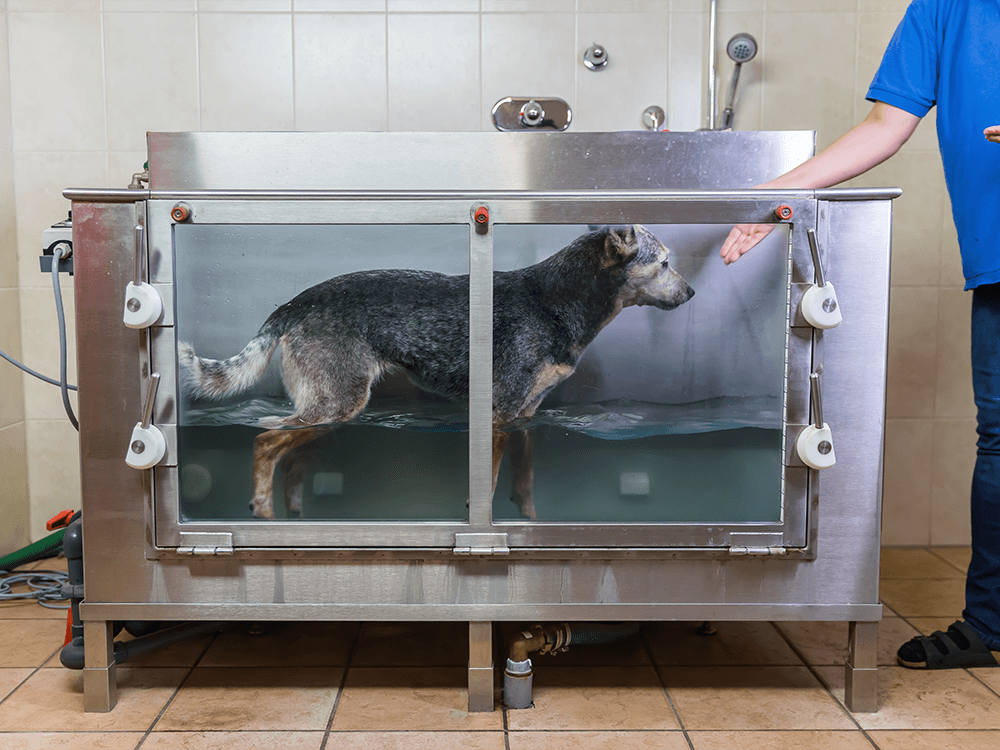Updated last 15th September 2020
Hydrotherapy for dogs is a type of therapeutic exercise that is done in water. This allows dogs to get their exercise in a non-weight bearing environment. It's a great alternative to regular exercise for dogs who have mobility issues.
Dogs of any size, age, breed, or health condition can benefit from hydrotherapy. Find out how canine hydrotherapy works and how it can affect your dog's physical and mental well-being.
 1. What is dog hydrotherapy?
1. What is dog hydrotherapy?
Also known as canine water therapy, canine hydrotherapy or water cure, hydrotherapy for dogs a weight-bearing exercise in water.
It makes use of the different properties of water, including buoyancy, hydrostatic pressure, resistance, and viscosity.
Whilst in water, your dog's body is weightless, thus, allowing him to move freely without placing too much pressure on his joints. Hydrotherapy can be included as part of post-surgery canine care.
2. Is hydrotherapy good for dogs?
Canine hydrotherapy is a therapeutic and fun way to exercise for your furry companion. It offers several perks that aids in keeping him fit and healthy. The following are the amazing benefits of hydrotherapy for dogs:
- Boosts recovery from injury or surgery The road to recovery can be quite uncomfortable for your dog. Sometimes it can even be excruciatingly painful. Canine hydrotherapy can help in reducing pain and discomfort. Since hydrotherapy sessions use water resistance and buoyancy, your pooch can easily move around without aggravating his wounds. This is particularly helpful in hydrotherapy for dog wounds. Moreover, it uses warm water which helps in relaxing and loosening tight muscles.
- Relieves pain caused by illnesses Dogs that suffer from arthritis, patella luxation, osteoarthritis, elbow dysplasia and hip dysplasia, and other painful conditions can get pain relief from hydrotherapy. They can get the workout they need without straining their joints and muscles. The warm water also helps in increasing blood circulation and relieving joint pains.
- An excellent option for workout Hydrotherapy can also be used for general fitness as it is a low-impact exercise suitable for dogs of any age. It prevents placing too much pressure on puppies' developing joints. Meanwhile, it helps older dogs maintain their muscle mass despite mobility difficulties brought by their age. Canine hydrotherapy works well for agility, working, and show dogs as it gives them a thorough workout. The use of cold water is advised for these dogs to keep their body temperature regular.
- Aids in weight loss Regular exercises tend to be strenuous, especially for obese or overweight dogs. Hydrotherapy allows dogs to burn many calories in a short period without stressing their joints. Thus, hydrotherapy is a safe workout for dogs that need to shed a few pounds.
- Builds water affinity If you want your dog to learn swimming or power through his fear of water, canine hydrotherapy is an excellent place to start. With the help of positive reinforcement, your dog will slowly learn to love splashing around the pool and have fun.
 3. What are the types of hydrotherapy for dogs?
3. What are the types of hydrotherapy for dogs?
There are three types of canine hydrotherapy. Each has different features and benefits, and all of them are carried out in a controlled environment.
- Underwater Treadmill This is the most common type of canine hydrotherapy. Dogs with joint pains and arthritis are an excellent fit for this exercise. The water exercise strengthens their joint muscles. It has a low impact on their joints because it removes the pressure of gravity. A hydrotherapy treadmill enclosed in a plastic or glass chamber is commonly used for this session. The exercise begins as your dog enters the chamber. Once the door is shut, water fills the chamber to the level a little over his legs. Then, the treadmill will begin to move slowly, prompting your dog to do the same.
- Whirlpool Therapy Whirlpool therapy helps relieve pains. It is suitable for dogs recovering from major surgeries. This type of water therapy uses a pool—a Jacuzzi but for dogs. The water level entirely depends on where your dog's injury is located. Before the hydrotherapy session begins, your dog will be placed in a safety harness. He will then be gradually submerged into the pool. After that, the warm jet stream of the whirlpool will massage his injured joints. This will alleviate any pain he may be feeling.
- Dog Pool This type of pool has a water current that provides resistance whilst your dog is working out. It is often used for flexibility, strength, and agility exercises. Dog pools are also great for canines with arthritis or degenerative joint diseases. In dog pool hydrotherapy sessions, the size and depth of the pool are determined by the vet or the hydrotherapist depending on the health issues of your dog. Before it starts, your dog will be placed in a floater or harness. Throughout the session, the hydrotherapist will be guiding and monitoring your dog's movements and progress.
4. Are there requirements to get my dog into canine hydrotherapy?
You will need to acquire veterinary consent before you can place your dog in water therapy. The vet will examine your dog to determine the kind of hydrotherapy that suits your dog.
Doing so will aid the hydrotherapist in understanding your dog's condition too. This way, they will be able to create a specialised plan that will help in your dog's recovery.
The progress of your dog should be discussed by the vet and the therapist so that they can adjust the water therapy sessions as they see fit.
 5. Are there any risks of hydrotherapy for dogs?
5. Are there any risks of hydrotherapy for dogs?
Hydrotherapy for dogs has lots of benefits, but it also has a few drawbacks. Here are some risks that you need to be aware of:
- Too much water in the ears can cause ear infections.
- The water can agitate your dog's skin problems if he has one.
- Unmonitored hydrotherapy sessions can lead to exhaustion and drowning.
Open wounds, urinary tract problems, and skin and ear infections must completely heal before going to hydrotherapy. Lack of proper knowledge on how hydrotherapy works can put your dog at risk too.
Incorrect water temperature and poor sanitation can endanger your dog's health. Wrong methods to stabilise him in water can strain his joints and muscles.
Thus, it is strongly suggested that hydrotherapy should be done by canine hydrotherapists. They are equipped with the specialised equipment and expertise on how to safely handle your dog whilst in water.
6. Can I accompany my dog inside the pool in canine hydrotherapy?
Most of the time, dog owners are allowed to join their pooches during hydrotherapy sessions. Experts believe that this strengthens the bond between owner and dog.
Moreover, the presence of the dog owner will relax the dog if he gets scared of the water. However, if the pool is small, you might not be permitted to accompany him.
 7. Will the chlorine in canine hydrotherapy be harmful to my dog?
7. Will the chlorine in canine hydrotherapy be harmful to my dog?
Canine hydrotherapy pools are similar to regular human pools as they both contain the same level of chlorine. This is to ensure that harmful bacteria such as E. coli and salmonella will be eliminated. The chlorine levels are also monitored regularly.
However, make sure to wash your dog after every session to remove the traces of chlorine. If you are still in doubt, you can ask the vet for advice.
8. How much is hydrotherapy for dogs in the UK?
The cost of water therapy for dogs may vary depending on the location and the facilities. It can range from £20 to £60 per session. Each session may last for up to 30 minutes, including your dog's drying time.
